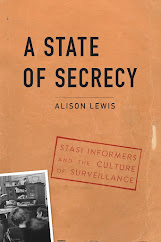Synopsis: Secret police agencies such as the East German Ministry for State Security kept enormous quantities of secrets about their own citizens, relying heavily on human modes of data collection in the form of informants. To date little is known about the complicated and conflicted lives of informers, who often lived in a perpetual state of secrecy. This is the first study of its kind to explore this secret surveillance society, its arcane rituals, and the secret lives it fostered.
Through a series of interlocking, in-depth case studies of informers in literature and the arts, A State of Secrecy seeks answers to the question of how the collusion of the East German intelligentsia with the Stasi was possible and sustainable. It draws on extensive original archive research conducted in the BStU (Stasi Records Agency), as well as eyewitness testimony, literature, and film, and uses a broad array of methods from biography, sociology, cultural studies, and literary history to political science and surveillance and intelligence studies. In teasing out the various kinds of entanglements of intellectuals with power during the Cold War, Lewis presents a microhistory of the covert activities of those writers who colluded with the secret police.
Lewis begins with a rather apt observation that no-one escapes the notice of the Stasi octopus ... informers and collaborators were the Trojan horses of the counter-revolution.
Lewis presents us with five interlaced biographical studies of writes who were Stasi informers - either by choice or by coercion. Through the medium of these cultural icons, Lewis "sets out to explore the secret surveillance society that enabled, controlled and subverted cultural life in the GDR". To this end, this is a well constructed study of the Stasi apparatus and its use of cultural diplomacy as a weapon against the subversive activities of its citizenry. However, by the 1980s, as people found the courage to refuse to collaborate, the Stasi found themselves with a distinct shortage of informers.
We find that through the stories presented that the Stasi preferred to "work" with people with intrinsic rather than extrinsic motivations - patriotism and ideology. All those featured had crossed paths at one point or another during their lifetimes - all joined for varying reasons. We find that the likes of Paul Wiens believed that the emancipation of Jews would come about through communism rather than fascism, and was one who enjoyed the "benefits" of collaboration. His daughter Maya was part of the Stasi machinery from an early period, though as a struggling novelist, became embittered with the struggle against censorship. Student Helga Navak was blackmailed into collaborating, but proved to be the least effective. Paul Gratzik was ideologically motivated, however still enjoyed the financial and materials gains to be had. And lastly Sascha Anderson, whose "employment" is still being questioned today - did he volunteer or was he recruited. Through these five, Lewis reveals an unholy alliance between the personal and political, and the private and the secret realm.
For those wishing to expand upon and enhance their knowledge and understanding of Stasi activities and the GDR machinery, this will make a compelling read. It is a well researched tome that explores the recruitment process, the motivations and ultimately, the justifications for collaboration. It also demonstrates that the Stasi did not necessarily need to employ "good cop bad cop" thug tactics to get what it wanted - a little sweetner here, a bit of blackmail there worked just as well. As the saying goes, you catch more flies with honey than vinegar - and the Stasi demonstrate this idiom rather well.
There are a number of other books dealing with specific aspects of the Stasi's use of certain societal and cultural segments, and this will prove a valuable addition to that core study group.



No comments:
Post a Comment